Disney World Trip Planning for Families Navigating Autism & Anxiety
- Practically Perfect Pixie Dust

- Jan 1
- 7 min read
Updated: Jun 30
***Updated 6/30/25
If you’ve spent any time on our blog, you know we’re a big Disney family. We go as often as we can—and we truly love it. But what’s less obvious is that Disney isn’t always an easy trip for us.

We have a family member on the autism spectrum who struggles with everyday interactions that many neurotypical guests might take for granted. We also have another who experiences social anxiety, especially in unfamiliar, crowded environments. Routine and safe spaces matter deeply—and theme parks, by nature, disrupt both.
So you can probably see why a Walt Disney World trip can be both magical and incredibly challenging for our family group. We’ve had to make adjustments, get creative, and learn how to plan with compassion and flexibility.
The good news? It is possible to have an amazing Disney trip—even with these hurdles. And we’re sharing the exact strategies that have worked for us over the years.
👇 Just need the quick plan?
Skip straight to our Step-by-Step Disney Trip Planning Guide for Families Navigating Autism and Anxiety
How We Approach Disney Planning as an Autism and Anxiety-Friendly Family
🎯 1. We set goals—and limits—before we even pack
Before anything gets booked, we start with research.
What’s new? What’s changed? Are there sensory overlays, construction walls, character changes, or ride refurbishments that might be unexpected? Knowing what to expect—especially for our family member on the spectrum—is vitally important.
We’ve learned that surprises can be triggering, even if they’re technically “fun.” That’s why we go over new shows, attractions, and even snack menus in advance—so nothing catches anyone off guard.
Once we’ve done our research, we talk as a family about what each person hopes to do, see, or eat. Everyone gets a voice.
Then we map those must-dos to realistic park days. We plan how much time we’ll need in each park and try not to overload our schedule. It’s tempting to do it all—but we’ve learned that less is often more.
🧚 Pixie Dust Pro Tip: Don’t skip pre-planning! Flexibility is important, but so is having a structure you can adapt from.
☀️ 2. We factor in crowd levels and weather
Crowds are hard for both our neurodivergent family members, but heat is an even bigger trigger. Florida is hot most of the year, but summer is especially intense. Even though holiday crowds can be thick, we choose them over the oppressive heat.
🧚♀️ Pixie Dust Pro Tip: If you’re sensitive to temperature, plan around it first. You can deal with crowds—you can’t escape the sun.
Need a little more help navigating Florida weather? ➡️ Check out our Beat the Heat and Rain Guides for each park.
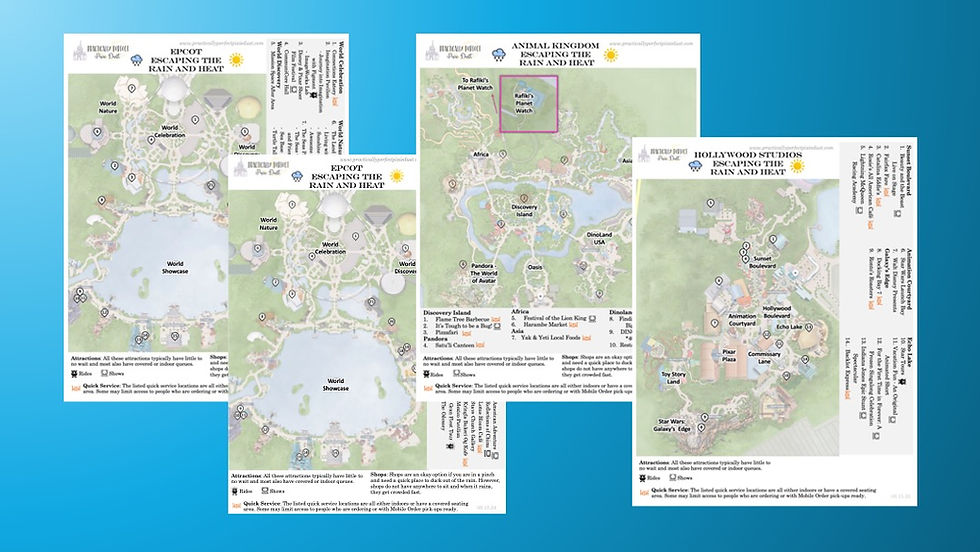
🗺️ 3. We plan our days geographically
Jumping from one side of the park to the other is exhausting for everyone—physically and mentally. So we group our plans by park sections to minimize walking and maximize predictability.
We also factor in sit-down shows, air-conditioned areas, and slower-paced experiences to help people recharge.
🛋️ 4. We build in breaks and buffer zones
We’ve learned to recognize the early signs of overwhelm and plan ahead for where to take a sensory break.
That might mean:
A midday return to the hotel
Catching a quiet show like Carousel of Progress
Finding a shady corner in Liberty Square to sit and snack
We’ve also made peace with the fact that we may need to leave a park early—and that’s okay.

🧚♀️ Pixie Dust Pro Tip: Check out our Quiet Spots for Sensory Breaks at each park.
🎆 5. We plan high-stimulation experiences very carefully
Fireworks shows and nighttime spectaculars are amazing—but they’re also intense. If we want to do one of these (like Fantasmic! or Happily Ever After), we come up with a plan:
Can we do a dessert party or a dining package for a quieter, more controlled spot?
Should we watch from the train station instead of in front of the castle?
Who’s the designated “exit buddy” in case someone needs to leave early?
We’ve found that planning only one big experience like this per trip works best.
🏨 6. We stay at resorts with less stressful transportation
We try to avoid the buses whenever we can. They’re crowded, loud, and unpredictable—especially at park close.

Instead, we prioritize:
Skyliner resorts (huge win for us!)
Monorail or Boat access
A small Uber budget for when we need to leave quickly
🍽️ 7. We don’t wing our meals
If we don’t plan ahead, someone ends up hangry—and that’s a recipe for disaster. Sit-down meals are a great break for us, so we try to book one per day and always make ADRs (Advance Dining Reservations) 60 days out.
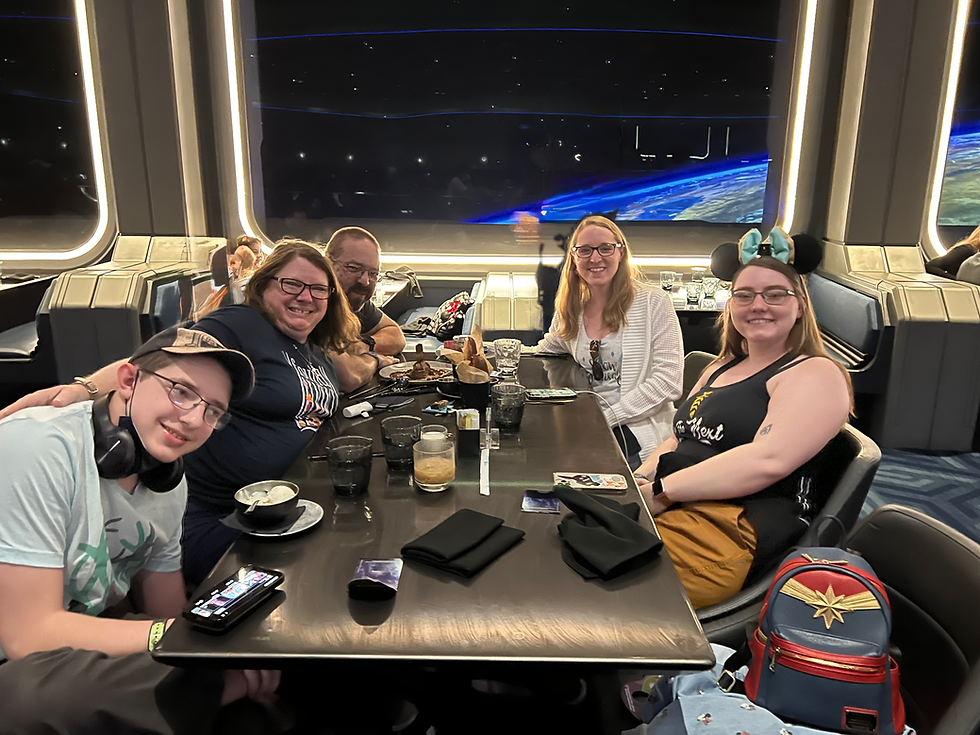
We also always pre-check menus and food options for sensory or dietary issues. You don’t want to be figuring that out on the fly in the heat with a hungry kid or adult who is half way to a hangry meltdown.
🎟️ 8. We apply for the DAS (Disability Access Service) accommodation
If someone in your party qualifies, apply for DAS up to 60 days before your trip through Disney’s online system. DAS allows guests to schedule return times for attractions, avoiding long waits in physical lines. We always apply in advance and make sure to have our top picks and backups ready before that first park day.
🧠 DAS Note: Disney has recently updated their DAS policies, and many guests who qualified before no longer do. If that’s your situation, you’re not alone. We’ve been there too—and we’ve done a lot of thinking about how to still make the trip work.👉 Read our tips and strategies for approaching WDW without DAS
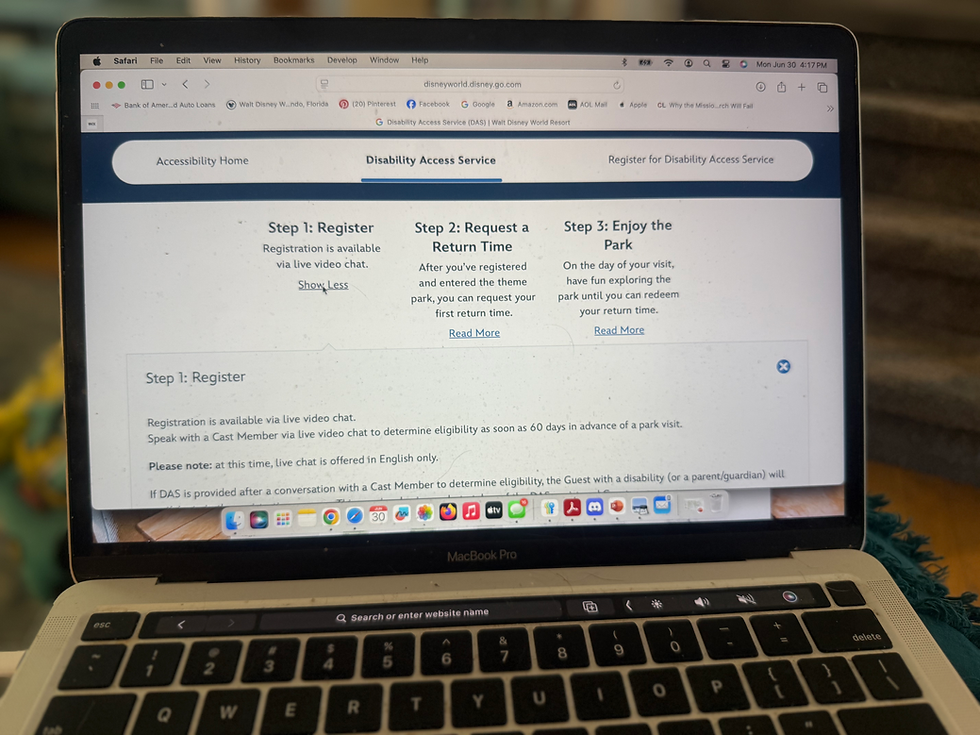
🧚 Pixie Dust Pro Tip: Need help navigating the updated process? Check out our DAS FAQ and our step-by-step guide to Registering for DAS at Walt Disney World.
For an overview of how the system works and who may qualify, visit our DAS at Walt Disney World info hub.
✈️ 9. We ease into the trip
Arrival day is a gentle day. Sometimes that means a half-park day and dinner before turning in early. Other times, we just relax at the pool or head to Disney Springs.
This gives everyone time to adjust to the new environment without pressure.
🧚 Pixie Dust Pro Tip: Looking for low-key fun outside the parks? Check out our guide to things to do beyond the parks at Walt Disney World.
🧠 10. We stay flexible—every single day
We plan with intention—but we also pivot with compassion. Sometimes that means skipping a must-do ride. Sometimes it means letting go of what we thought the day would look like.
The goal isn’t to check every box. It’s to help each person feel heard, supported, and part of the magic.
🧩 🧩 More Resources for Neurodiverse & Accessible Travel
Looking for more tools to make your trip smoother, more inclusive, and full of magic? Check out our full set of planning guides:
🧠 Disney Travel with Neurodiversity – Sensory-friendly strategies, prep tips, and calm spaces across Walt Disney World.
♿ Limited Mobility at Disney – Stroller-as-wheelchair policies, ride transfer info, and ECV tips for every park.
🎟️ Disney’s Disability Access Service (DAS) Guide – What it is, who qualifies, and how to use it for a smoother park day.
❌ Managing a Disney Trip Without DAS – Alternative strategies if you don’t qualify under new DAS rules.
🧭 Accessibility at Disney Overview – Your hub for all things inclusive, from visual aids to service animal policies.
🌤️ Beat the Heat and Rain: Survival Guides for Every Park – Tips to navigate Florida weather without getting overwhelmed.
👉Preparing a Child with Autism for a Walt Disney World Trip- The tools, tips, and strategies that worked for our family.
🧚 Pixie Dust Pro Tip: Bookmark this page or save it to Pinterest so you have everything in one place when it’s time to plan!
✅ Recap: Our Step-by-Step Disney Trip Planning Guide for Families Navigating Autism and Anxiety
Set goals—and limits.Let everyone share must-dos. Prioritize what matters most—not doing it all.
Research what’s new.Helps prep for changes and avoid surprise triggers.
Group your park plans geographically.Less walking = more stamina.
Avoid extreme heat.We skip summer in favor of cooler months.
Build in breaks.Shows, shade, or mid-day hotel rests help everyone.
Prep for fireworks & nighttime shows.Limit to one per trip. Reserved viewing helps reduce overwhelm.
Plan for crowd management.Use Lightning Lane Multi Pass, quiet areas, and avoid high-traffic transitions when possible.
Book easier transportation.Skyliner, boats, or monorail > buses. Budget for Uber when needed.
Apply for DAS early.If you don’t qualify, explore LLMP or use our DAS Alternatives Guide.
Ease in—and stay flexible.Arrival day = low key. Pivot as needed and check in with each other often.
📥 Prefer a visual version? Download the PDF or JPG or save it on your phone to reference as you plan.
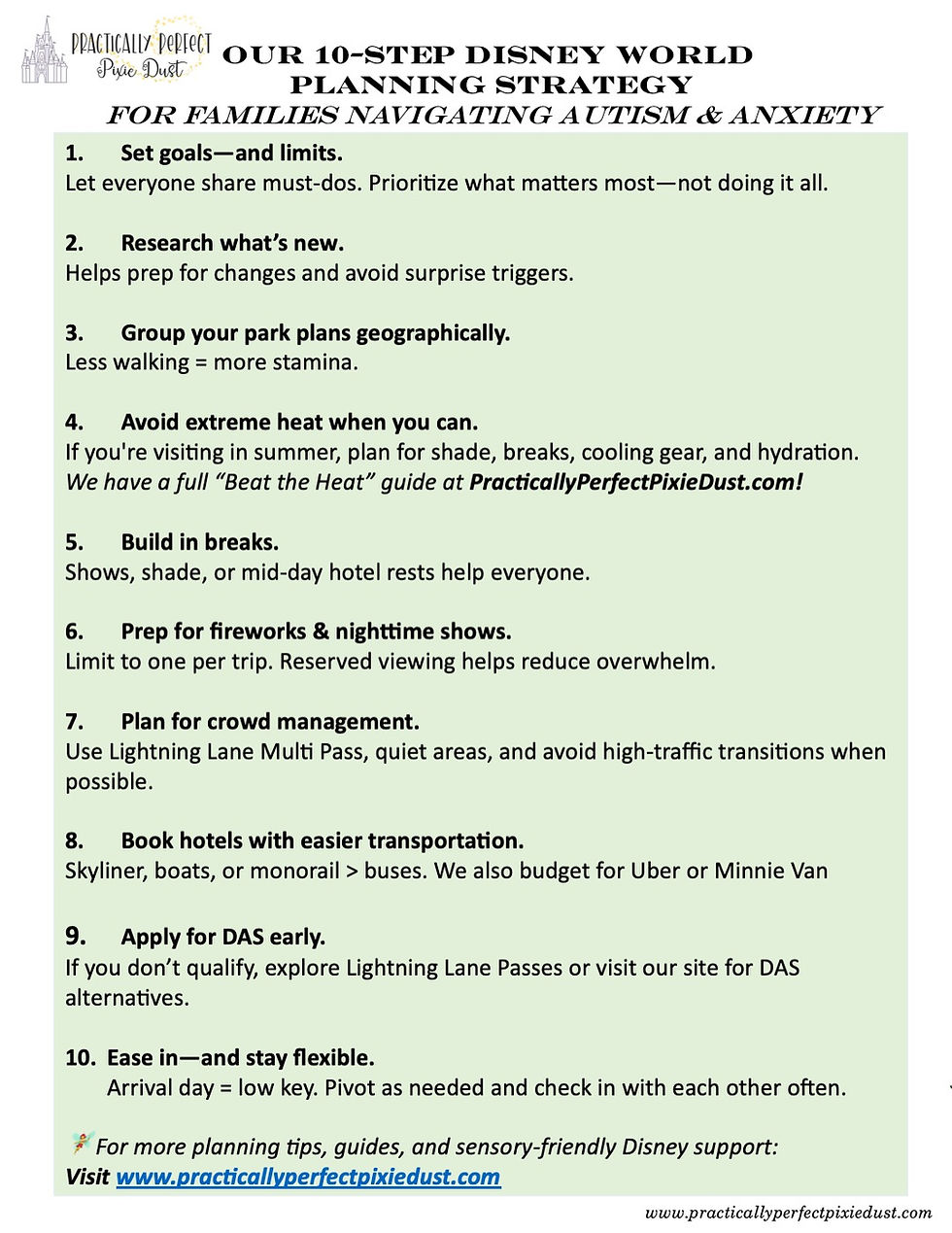
✨ Final Thoughts
Planning a Disney trip with a neurodivergent family member isn’t always easy—but it is absolutely possible. With some thoughtful planning, a flexible mindset, and a lot of compassion (for your family and yourself), you can create magical moments that truly matter.
We spent years trying to find the kind of practical, empathetic advice we needed—especially when planning for our own family members on the spectrum. The truth is, it didn’t really exist. So we’re writing and creating the guides we always wished we had.
Whether it’s your first visit or your fifteenth, we hope our experience helps you feel more confident, more supported, and a little less alone on the journey.
And remember: You don’t have to do everything to have the perfect Disney day—just the things that matter most to your family.
Whether it’s your first visit or your fifteenth, we hope our experience helps you feel more confident, more supported, and a little less alone on the journey.
Pixie Dust Hugs,
Bren, Lyn, and Kim
P.S. Planning your own magical getaway?






































































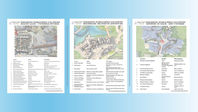






















Comments